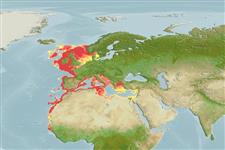Classificação / Names
Common names from other countries
Referência principal
Tamanho / Peso / Idade
Max length : 100.0 cm TL macho/indeterminado; (Ref. 244); common length : 60.0 cm TL macho/indeterminado; (Ref. 4645); Peso máx. publicado: 1.3 kg (Ref. 40637); Idade máx. registada: 12 anos (Ref. 81067)
Length at first maturity
Lm 57.0, range 41 - 64 cm
Ambiente
; marinhas demersal; intervalo de profundidade 10 - 780 m (Ref. 56504), usually 80 - 100 m (Ref. 81056)
Clima / Intervalo
Subtropical, preferred 21°C (Ref. 107945); 63°N - 12°N, 18°W - 36°E
Distribuição
Northeast Atlantic: Norway and British Isles south to Senegal, including the Mediterranean. Possibly Côte d'Ivoire. Some populational differences exist between Catulus duhameli (a name for the Mediterranean canicula based on size) and this species which may eventually be expressed as subspecies. The only reported observation of this species in Crimean waters was in 1937, which is possibly erroneous (Ref. 897).
Países | Áreas FAO | Ecossistemas | Ocorrências | Introduções
Descrição breve
Espinhos dorsais (total): 0; Raios dorsais moles (total): 0; Espinhos anais 0; Raios anais moles: 0. A slender, dark-spotted catshark with 8-9 dusky saddles (often obscure or absent), greatly expanded anterior nasal flaps, reaching mouth and covering shallow nasoral grooves, labial furrows on lower jaw only, first dorsal fin originates well behind the pelvic fins, second dorsal fin much smaller than first (Ref. 244).
Categoria na Lista Vermelha da IUCN (Ref. 115185)
Ameaça para o homem
Harmless
Utilização humana
Pescarias: pouco comercial
Mais informação
ReferênciasAquaculturaPerfil para aquaculturaEstirpesGenéticaFrequência dos alelosHereditariedadeDoençasProcessamentoMass conversion
Ferramentas
Relatórios especiais
Descarregue XML
Fontes da internet
Estimates of some properties based on models
Phylogenetic diversity index
PD50 = 0.5000 many relatives (e.g. carps) 0.5 - 2.0 few relatives (e.g. lungfishes)
Nível Trófico
3.8 ±0.3 se; Based on diet studies.
Resiliência
Baixo, tempo mínimo de duplicação da população 4,5 - 14 anos (K=0.20; tm=9; Fec=96)
Vulnerabilidade
High vulnerability (62 of 100)
Categoria de preço
